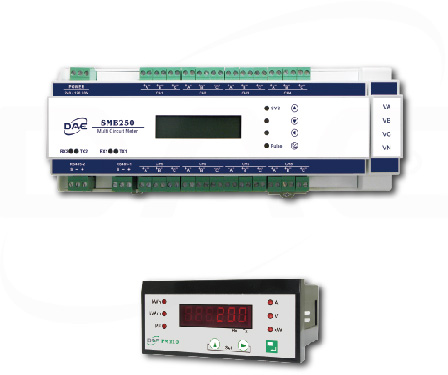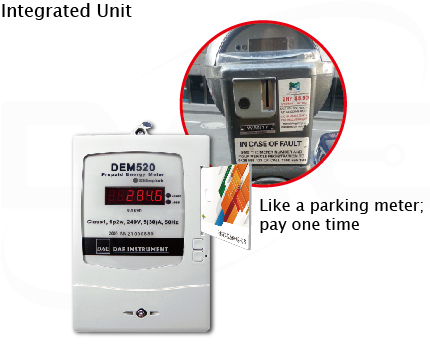Energy Meter Concepts
Meter Types

- By Purpose: Smart meters can either be revenue or M & V (measurement & verification)types。
- Revenue Meters: These are primarily used for revenue collection, and are each meter unit is required to be individually certified by a goverment standards agency.
- M & V meter: These are mainly used for energy monitoring and management use, these only need to have their accuracy tested by an independent third party lab and does not require individual unit certification.
- Measured Values: kW, kWh, and multi-function.
- Current Input: Pass-through (direct input) or requiring an external CT.
- By Automation:
- Remote connected
- Pay as you go smart card
- Prepaid smart card
- Online stored value
Auto Meter Reading

- The main reason for installing either water or electricity meters is to be able to collect and log actual data on either water or elecricity use, which can later be used for evaluation or bill collection.
- For installations with numerous electricity or water meters, especially if they are widely scattered and not easy for a person to collect the meter readings.
- Most facility managers would prefer to have automated software system that would be linked with the various scattered meters for the purpose of monitoring and logging. Which is why the meters would need to have an RS485 interface, this is the essense of having smart meters.
Types of CTs

Considerations for selecting external CTs:
- Except for direct connect meters, most other meters have external CTs.
- Regular vs dedicated CTs:
- Regular 5A output CTs: Suited for 200 amperes or higher, otherwise the accuracy suffers. These are also quite large and occupies a lot space, often requiring installing a new panel just for the CT.
- Dedicated CTs: These are quite small, suitable for subcircuits with 200 amperes or less, and can be retrofitted into existing panels.
- Solid core or split core:
- Split Core: High cost, easy and convenient to install and is well suited for installations where power interruption is absolutely not allowed.
- Solid Core: Low cost, but power needs to be interrupted or wire cut during installation.
Revenue Meters

- Tariff meters are broadly used for billing purposes; as for example the meters installed in each home and business is a revenue type meter, as well as the submeters installed in rental apartments and school dormitories.
- Most revenue meters only shows the cumulative energy information, and each meter needs to be individually by a government standards and measures agency before being put into service; once certified the agency will attach a sticker to the front and seal the unit with an official lead seal.
- Smart meters with communication capability are available in two types:
- No Relay: For auto meter reading use
- Built-in Relay: For use with Pay-as-you-go meter, prepaid meter, remote controllable meter
Multi-Function Meters

Unlike kWh meters, multi-function meters also measures for voltage, current, power, power factor, real and reactive energy, and frequency
- Revenue Meter: For billing purposes
- Panel Meter: For feeder circuits
- Multi-Circuit Meter: For branch circuits
Monitoring Meters
Energy meters used for M & V are indispensable for energy management, aside from providing the basic kWh measurements, they can also measure the voltage, current, power, power factor and other energy related data; these data can be transmitted to a remote host for logging and later analysis; reports allows for detecting anomalies, improving performance, consumption records and so on. They are an essential component for any smart building initiative.

Prepaid Card Meters

Pay-As-You-Go Type

Value Transfer Type
Remote Stored Value Meters

Remote stored value meters have communication and a built-in relay. They work similar in concept to prepaid mobile phones, a certain amount of credits (in kWh) is stored within the meter itself. As energy is being consumed, the remaining credits is reduced accordingly; when no credits remain, the meter will cut off the power.
Based on this mechanism, the burden to the landlord can be greatly reduced, they would no longer need to assign someone or bring any device to the rental site just to dispense credit.
